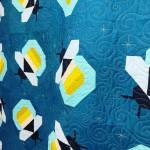Quilt Block Mania – May 2025 – Propeller
The Quilt Block Mania theme for May 2025 is “Up in the Air.”
Well, with a husband who flew his first solo flight on his 16th birthday and has spent his entire career as a pilot, this block had to be airplane related!
This is a very simple block, but with the illustrated colors, it represents the propeller on a single-engine airplane cutting through a blue sky.
The “Propeller” block below is made using traditional piecing techniques and finishes at 12″ square.
This block pattern is available for FREE until June 30, 2025. After that, it will be available in my Pattern Shop.

Please be sure to check out these other “Up in the Air” quilt blocks from the other Quilt Block Mania designers this month!
Pig with wings by Carolina Moore
Kite with tail
Daylight Flight by Patti's Patchwork
Hot Air Balloon by QuiltFabrication
Pancakes by Inquiring Quilter
Feeding Time by Robin Kinley Designs Etc
Contrails by Memory Barn Studio
Scrappy Birds by Katie Mae Quilts
Propeller by Patchwork River Quilting
Pinwheels and Northern Lights by The Quilted Diary
Space Rocket by Emerald Falls Quilts
Pilot Nutcracker
Flying Birds by Patchwork Breeze
Raven's Flight by A Piece of Quiet Quilts
Butterfly by Appliques Quilts and More
Night Sky by Studio B

- Patchwork River Quilting
- Quilt Block Mania
- May, 06, 2025









































